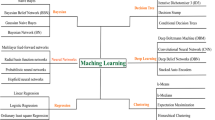Abstract
A back propagation artificial neural network approach is applied to three common challenges in engineering geology: (1) characterization of subsurface geometry/position of the slip (or failure surface) of active landslides, (2) assessment of slope displacements based on ground water elevation and climate, and (3) assessment of groundwater elevations based on climate data. Series of neural network models are trained, validated, and applied to a landslide study along Lake Michigan and cases from the literature. The subsurface characterization results are also compared to a limit equilibrium circular failure surface search with specific adopted boundary conditions. It is determined that the neural network models predict slip surfaces better than the limit equilibrium slip surface search using the most conservative criteria. Displacements and groundwater elevations are also predicted fairly well, in real time. The models’ ability to predict displacements and groundwater elevations provides a foundational framework for building future warning systems with additional inputs.











Similar content being viewed by others
References
Baker R, Leshchinsky D (2001) Spatial distribution of safety factors. J Geotech Geoenviron Eng 127(2):135–145
Bishop AW (1955) The use of the slip circle in the stability analysis slopes. Geotechnique 5(1):7–17
Bishop C (1995) Neural networks for pattern recognition. Oxford Press, New York
Cao J (2002) Neural network modeling and analytical modeling of slope stability, PhD. University of Oklahoma, USA
Chase RB, Chase KE, Kehew AE, Montgomery WW (2001a) Determining the kinematics of slope movements using low-cost monitoring and cross-section balancing. Environ Eng Geosci 7(2):193–203
Chase RB, Kehew AE, Montgomery WW (2001b) Determination of slope displacement mechanisms and causes using new geometric modeling techniques and climate data. In: Harmon RS, Doe WW (eds) Landscape erosion and evolution modeling. Kluwer Academic Publishers, New York, p 111
Chase RB, Kehew AE, Glynn ME, Selegean JP (2007a) Modeling debris slide geometry with balanced cross-sections: a rigorous field test. J Environ Eng Geosci 13(1):45–53
Chase RB, Kehew A, Kaunda RB, Glynn ME (2007b) Mitigation of slope failures in freeze/thaw environment by removal of ground water. In: Proceedings of the First North American Landslide, Vail, CO
Chen WH (1975) Limit analysis and soil plasticity. Elsevier, Amsterdam, 638 p
Chowdhury RN (1978) Propagation of failure surfaces in natural slopes. J Geophys Res 83:5983–5988
Coppola EA, Rana AJ, Poulton MM, Szidarovsky F, Uhl VW (2005) A neural network model for predicting aquifer water level elevations. Ground Water 43(2):231–241
Duncan JM (1996) State of the art: limit equilibrium and finite element analysis of slopes. J Geotech Eng 122(7):577–596
Ghaboussi J, Sidarata DE (1998) New nested adaptive neural networks (NANN) for constitutive modeling. Comput Geotech 22(1):29–52
Griffiths DV, Fenton GA (2004) Probabilistic slope stability analysis by finite elements. J Geotech Geoenviron Eng 130(5):507–518
Griffiths DV, Lane PA (1999) Slope stability analysis by finite elements. Geotechnique 49(3):387–403
Habibagahi G, Bamdad A (2003) A neural network framework for mechanical behavior of unsaturated soils. Can Geotech J 40:684–693
Haykin S (1999) Neural networks: a comprehensive foundation, 2nd edn. Prentice Hall, New Jersey
Janbu N (1968) Slope stability computations. Soil mechanics and foundation engineering report. Technical University of Norway, Trondheim
Juang CH, Jiang T, Christopher RA (2001) Three-dimensional site characterization: neural network approach. Geotechnique 51(9):799–809
Kamai T (1998) Monitoring the process of ground failure in repeated landslides and associated stability assessments. Eng Geol 50:71–84
Liu Y, Guo H, Zou R, Wang LJ (2006) Neural network modeling for regional hazard assessment of debris flow in Lake Qionghai Watershed, China. Environ Geol 49:968–976
Neaupane K, Achet S (2004) Some applications of a back propagation neural network in geo-engineering. Environ Geol 45:567–577
NeuralWare (2006) NeuralWorks Predict software, version 3
Nielsen RH (1998) Neurocomputing, picking the human brain. IEEE Spectr 25(3):36–41
Nieuwenhuis JD (1991) The lifetime of a landslide: investigations in the French Alps. A.A. Balkema, Rotterdam, 144 p
Petley DN, Carey J, Higuchi T, Petley DJ, Bulmer MH (2005) Development of progressive landslide failure in cohesive materials. Geology 33(3):201–204
Poulton M (2001) Computational neural networks for geophysical data processing. Paragons Press Ltd, Amsterdam, 335 p
Rocscience (2006) Slide Software, version 5.0
Rumelhart DE, Hinton GE, Williams RJ (1986) Learning internal representations by error propagation. In: Rumelhart DE, McClelland JL (eds) Parallel distributed processing, vol 1. MIT Press, Cambridge, pp 318–362
Rutter EH, Arkwright JC, Holloway RF, Waghorn D (2003) Strains and displacements in the Mam Tor landslip, Derbyshire, England. J Geol Soc 160:735–744
Skempton AW, Leadbeater AD, Chandler RJ (1989) The Mam Tor landslide, North Debyshire. Philos Trans Roy Soc Lond Ser A 329:503–547
Stark TD, Choi H, McConne S (2005) Drained shear strength parameters for analysis of landslides. J Geotech Geoenviron Eng 131(5):575–588
Suemine A (1983) Study on landslide mechanism in the area of crystalline schist (part 1)—an example of propagation of Rankine state. Bull Disaster Prev Res Inst Kyoto Univ 33(3):105–127
Van Genuchten PMB, Nieuwenhuis JD (1990) On the stability of seasonally sliding soil masses in the French Alps. Eng Geol 28:41–69
Wang HB, Xu WH, Xu RC (2005) Slope stability evaluation using back propagation neural networks. Eng Geol 80:302–315
Wasserman P (1989) Neural computing: theory and practice. Van Nostrand Reinhold, New York
Acknowledgments
We wish to acknowledge funding for the field studies from the US Army Corps of Engineers Engineering Research and Development Center (ERDC), and the Detroit District USACE. Western Michigan University provided both financial and logistical support. We are grateful to the property owners in Allegan County, MI, Allegan County Road Commission, and State of Michigan for granting access to the study site. Three anonymous reviewers provided helpful comments and suggestions. We also thank Dr. William Sauck, Department of Geosciences for reviewing the manuscript.
Author information
Authors and Affiliations
Corresponding author
Rights and permissions
About this article
Cite this article
Kaunda, R.B., Chase, R.B., Kehew, A.E. et al. Neural network modeling applications in active slope stability problems. Environ Earth Sci 60, 1545–1558 (2010). https://doi.org/10.1007/s12665-009-0290-3
Received:
Accepted:
Published:
Issue Date:
DOI: https://doi.org/10.1007/s12665-009-0290-3




